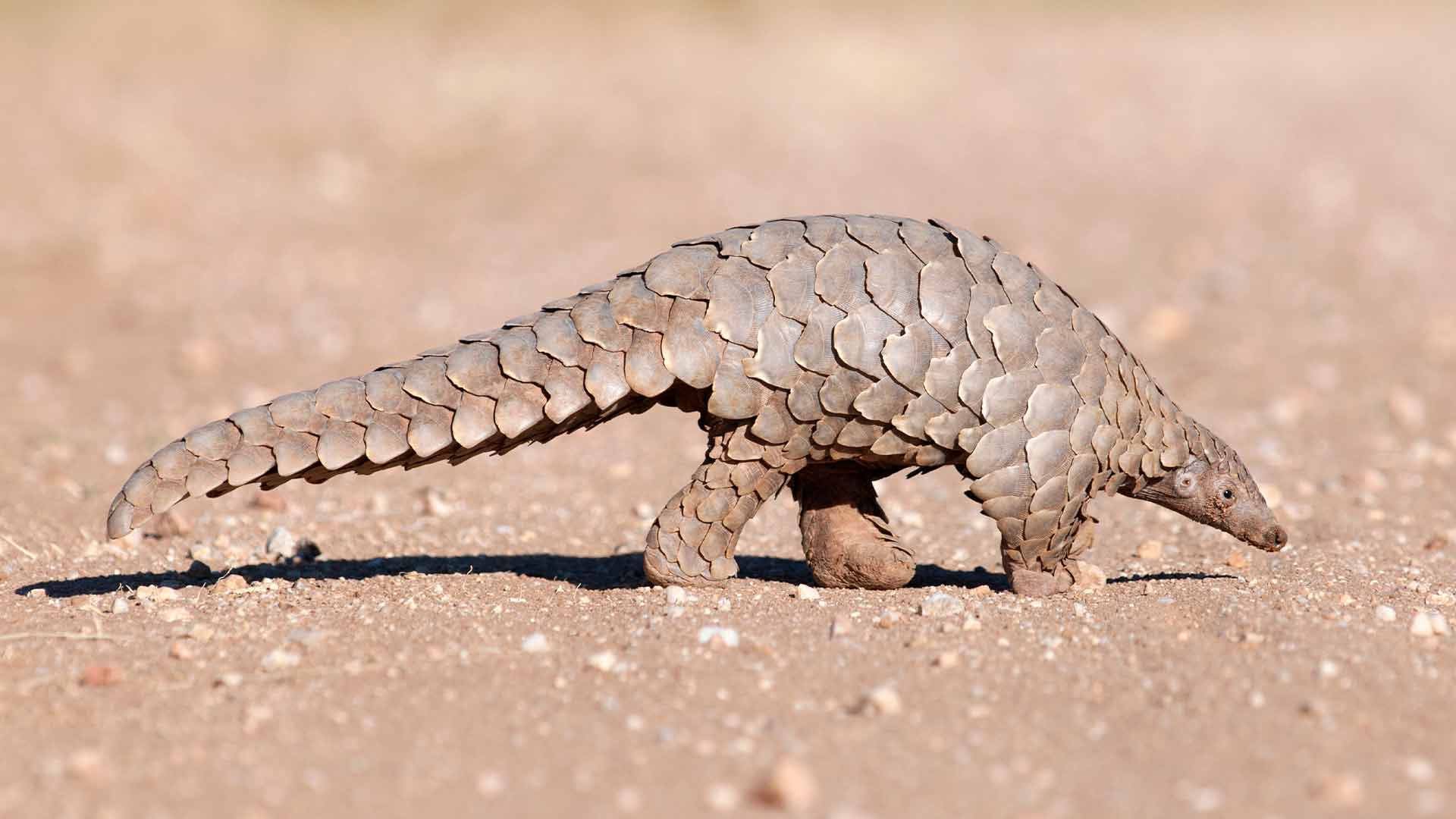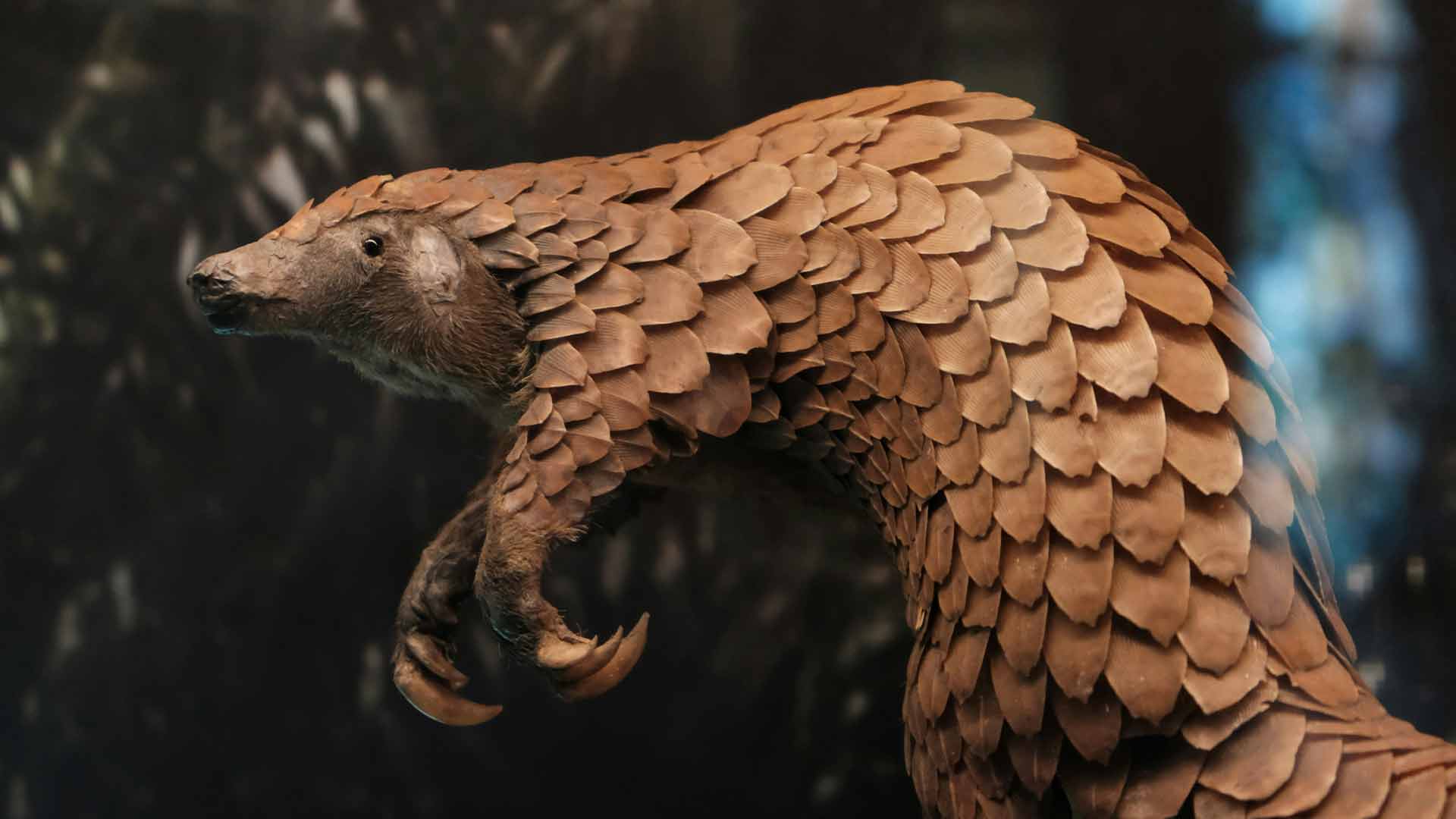Pangolin
Spotlighting a unique mammal with defensive scales, insect-rich diet, and critical conservation challenges posed by human activities.

Overview
The Pangolin, a remarkable mammal native to Africa, stands out for its distinctive armored scales, which serve as a protective shield against predators and environmental hazards.
With a primarily insectivorous diet, Pangolins are adept at foraging for ants and termites using their long, sticky tongues. Their nocturnal and solitary nature adds to their enigmatic charm, as they navigate savannahs, grasslands, and forests across the African continent. However, Pangolins face significant threats, including poaching for their scales and meat, habitat loss due to human activities, and illegal wildlife trade, making them one of the most endangered mammals in Africa and highlighting the urgent need for conservation efforts to protect these fascinating creatures and their habitats.
Scientific Classification
- Kingdom: Animalia
- Phylum: Chordata
- Class: Mammalia
- Order: Pholidota
- Family: Manidae
Description
Pangolins are characterized by their protective scales made of keratin, similar to human fingernails, which they use as armor against predators. They have long, sticky tongues for capturing ants and termites, their primary diet. Pangolins come in two species in Africa: the African Giant Pangolin (Manis gigantea) and the Temminck’s Ground Pangolin (Smutsia temminckii), both distinguished by their size and scale patterns.
Body Structure
Pangolins have a robust and cylindrical body, covered in overlapping scales made of keratin, similar to human fingernails. These scales provide protection against predators and environmental hazards.
Scale Color and Pattern
The coloration of pangolin scales varies depending on the species and habitat, ranging from shades of brown, gray, and black. The scales form intricate patterns, resembling artful armor that helps the pangolin blend into its surroundings.
Size and Weight
Pangolins vary in size depending on the species, with the African Giant Pangolin (Manis gigantea) being the largest, reaching lengths of up to 1.8 meters (6 feet) and weights exceeding 30 kilograms (66 pounds). In contrast, the Temminck’s Ground Pangolin (Smutsia temminckii) is smaller, averaging around 1 meter (3.3 feet) in length and weighing approximately 5 to 9 kilograms (11 to 20 pounds).
Limbs and Claws
Pangolins have powerful limbs equipped with sharp claws, which they use for digging into ant and termite mounds to extract their prey. Their forelimbs are particularly strong, aiding in burrowing and climbing.
Tail
Pangolins have prehensile tails that they use for balance and support when climbing trees or maneuvering through vegetation. The tail also serves as a defense mechanism, curling around the pangolin’s body when threatened.
Facial Features
Pangolins have small eyes and ears, adapted to their nocturnal lifestyle. Their elongated snout houses a specialized tongue that can extend up to 40 centimeters (16 inches), allowing them to probe deep into termite mounds and ant nests to feed.
Dentition
Pangolins lack teeth in their mouth, relying solely on their long, sticky tongues to capture and consume insects. Their digestive system is adapted to process the chitinous exoskeletons of ants and termites efficiently.

Behaviour
Pangolins are nocturnal and solitary creatures, spending their nights foraging for insects. When threatened, they curl into a ball, using their scales as a defense mechanism.
Nocturnal and Solitary: Pangolins are primarily nocturnal creatures, active during the night and resting during the day in burrows or dense vegetation. They are solitary animals, typically avoiding interactions with other pangolins except during mating season.
Foraging Behavior: Pangolins are specialized insectivores, primarily feeding on ants and termites. They use their strong claws and elongated tongues to excavate ant and termite mounds, consuming large quantities of insects each night.
Defense Mechanisms: When threatened, pangolins employ several defensive tactics. Their first line of defense is curling into a tight ball, protecting their soft underbelly with their tough scales. This behavior, known as “balling up,” makes it challenging for predators to attack vulnerable areas.
Scent Marking: Pangolins use scent marking as a means of communication and territory marking. They have glands near the base of their tails that secrete a musky odor, which they rub on objects to establish their presence and convey information to other pangolins.
Arboreal and Terrestrial: While some pangolin species are more arboreal, climbing trees to access food or escape predators, others are predominantly terrestrial, moving across savannahs, grasslands, and forests in search of food and suitable habitats.
Reproductive Behavior: Pangolins typically mate during specific times of the year, with males engaging in courtship displays to attract females. Female pangolins give birth to one offspring at a time, which they care for diligently until the young pangolin becomes independent.
Interaction with Humans: Pangolins are shy and elusive around humans, often avoiding contact or retreating into hiding when encountered. Unfortunately, this behavior makes them vulnerable to illegal wildlife trade and habitat destruction, leading to population declines and conservation concerns.
Habitat
Pangolins are adaptable to various habitats, including savannahs, grasslands, woodlands, and forests. Their ability to thrive in diverse ecosystems reflects their generalist foraging behavior and burrowing habits. In Africa, pangolins are commonly found in savannah and grassland habitats, where they forage for ants and termites in open areas with suitable soil conditions for termite mounds.
Pangolins are distributed across sub-Saharan Africa, with species like the African Giant Pangolin (Manis gigantea) found in countries from the southern regions of South Africa to the eastern savannahs of Kenya and Tanzania, and further north into countries like Uganda, Nigeria, and Ghana, these unique mammals have adapted to various environments. They also thrive in Central African countries such as the Democratic Republic of the Congo, Cameroon, and Gabon, where dense forests provide ample food sources. Additionally, pangolins are present in countries like Zimbabwe, Zambia, Angola, Mozambique, and the Central African Republic, showcasing their ability to inhabit savannahs, woodlands, and transitional zones.
Conservation
Facts
Interesting facts about Pangolin
There are eight species of Pangolins, four in Africa and four in Asia.
Pangolin scales are made of keratin, the same material as human hair and nails.
Pangolins curl into a ball when threatened, using their scales as armor.
Pangolins primarily eat ants and termites, using their long tongues to extract insects from mounds.
Yes, some Pangolin species are excellent climbers and use trees for shelter and foraging.
Pangolins are not fast runners but are agile and can move quickly when necessary.
Pangolins lack teeth in their mouths and instead rely on their tongues to catch and swallow prey.
Pangolins can live up to 20 years in captivity, but their lifespan in the wild is often shorter due to threats.
The main threat to Pangolins is poaching for their scales, meat, and use in traditional medicine.
Yes, all eight species of Pangolins are threatened with extinction due to illegal wildlife trade and habitat loss.
Other Animals
Explore fauna in Africa.






